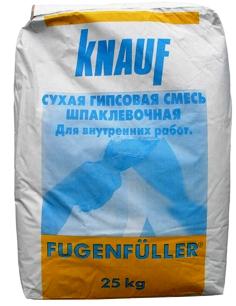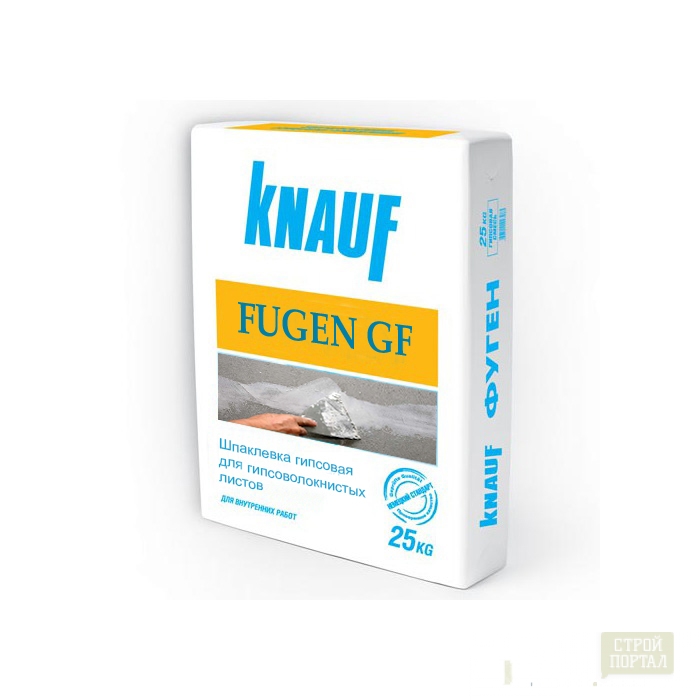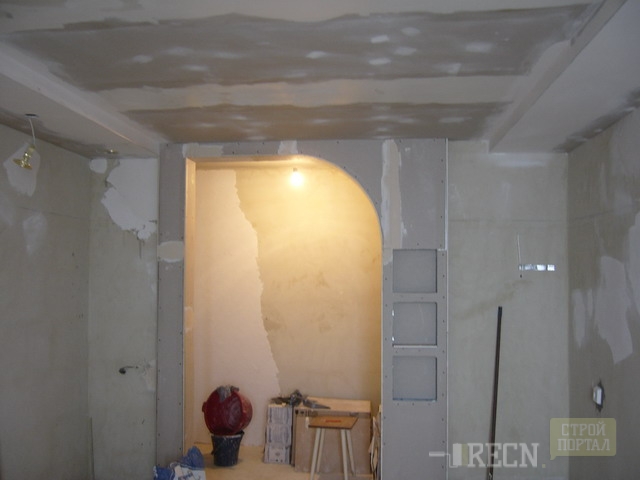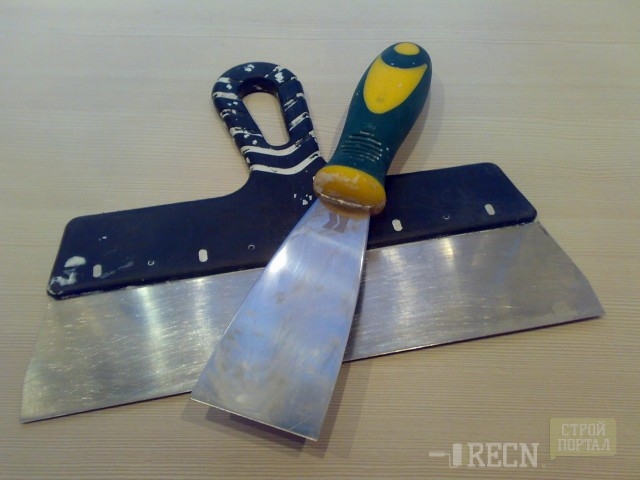
Everyone knows that the fugenfüller is ideal for leveling walls and sealing joints plasterboard sheets, filling various cracks and grooves in the walls, as well as sealing grooves when laying hidden electrical wiring.
Everyone knows that the surface of the walls must be thoroughly cleaned of dust before applying putty. But there are at least two mistakes that even experienced professionals make when using this wonderful material.
The first mistake is made when sealing large grooves and grooves with a depth of 15-25 millimeters. Trying to save time, they close the groove immediately to “zero”, filling the entire volume of the groove with the cable. When drying, the fugenfüller increases its volume and a tubercle 2-3 millimeters high appears along the groove, which is very problematic to clean off after a day.
Since this putty material has great hardness. It is necessary to fill the groove 85-90 percent, let the putty dry and only then level the wall.

The second error occurs again when sealing large grooves. Fugenfüller is a variety gypsum putty and has a relatively short hardening time. And, as a rule, within a day it allows application to it. finishing putty.
But if deep grooves were simultaneously sealed on the wall being leveled, then the required drying time before applying the finishing putty should be increased to at least three days. Otherwise, cracks in the place of the groove cannot be avoided.
The reason is the complete drying of the finishing putty, under which the fugenfüller has not yet completely dried. In this case, even small linear expansions of the fugenfüller layer that continues to harden can lead to cracks.
And it’s also good if you didn’t have time to paint the wall or put wallpaper on it. But the danger in this situation, as a rule, lurks only subtle paper wallpaper. Thick wallpaper, such as non-woven wallpaper, can withstand small cracks.
Another note about the wallpaper. Here, too, sometimes a mistake is made when using a fugenfüller. But only completely inexperienced craftsmen with golden hands allow it. Precisely with gold ones, since few people would dare to putty their own apartment without having any professional experience in construction.
Some people try to paste wallpaper directly onto the fugenfüller. And the wallpaper comes off the walls safely. Fugenfüller - putty for leveling walls! And on top of it it is necessary to apply a layer of finishing putty.
I’m not writing here about how to properly prepare putty for work - enough is written about this in the instructions. And here I am only summarizing my experience when using this material.
Packaging: 28 kg bucket.
Consumption: 1 kg of mixture per 1.8 - 2.5 m2 with a layer of 1 mm.
This is a powdered gypsum material with the addition of mineral additives that slow down the setting and hardening of gypsum, and also retain water in the induced composition.
For high-quality and fast work with gypsum Fugenfüller you need to prepare the tool:
The tool for carrying out the work must be made of of stainless steel. After puttying work, the tool must be cleaned of any remaining mortar. Fugenfüller KNAUF.
Specifications
Strength indicators
Gypsum putty universal KNAUF-Fugenfüller
Putty dry mixture KNAUF Fugen fuller on a gypsum basis is intended for carrying out internal repair work in rooms with normal humidity.
KNAUF Fugen mixture is perfect for the following finishing and repair work:
For drywall with a semicircular recessed edge and a recessed edge for sealing joints in them using serpyanka (reinforcing tape);
For mounting (gluing) plasterboard sheets KNAUF And various panels to bases with a flat surface;
To create a finishing thin-layer putty on various substrates (plastered surfaces, concrete foundations);
In structures made of gypsum and concrete blocks, filling seams and joints;
To carry out repair work in the resulting damage and cracks in gypsum structures made of plasterboard GKL, GVL;
For installation and gluing of gypsum blocks and PGP elements.
Fügen Fühler putty consumptionKNAUF:
Without taking into account the consumption of losses, the building mixture with a layer thickness of 1 mm per m2 is approximately 0.8 kg for continuous puttying, and for creating fillers in the joints between joints in plasterboard sheets it is 0.25 kg.
Of the main technical characteristics indicated manufacturer KNAUF it is worth noting dry mixture Fugen has fine fraction no more than 0.15 mm, but from one kg. The gypsum mixture produces 1.3 liters of ready-made mortar. Indicators of hardened strength gypsum material are 5.2 MPa in compression, 2.7 MPa in bending.
IN preparatory activities surface enters and is carried into next sequence:
Works with Fugenfüller putty are carried out on solid, non-deforming bases that are free of dirt and dust and have a dry surface. It is also important that the temperature of the base on which Fugen Knauf is applied does not fall below +10 C. Any remaining formwork lubricant on concrete bases is removed, as well as any other contaminants. Wet surfaces are dried.
Surface preparation for puttying is carried out in the following order. The surface itself should not be cold (at least + 10 degrees), the surface should be durable and dry. When working with drywall joints, all existing contaminants (dust, dirt, etc.) are removed using the dry method.
Porous substrates that strongly absorb moisture should be treated with Knauf primer for highly absorbent surfaces. The primer is applied to the surface using a roller, brush or spray. Bases that have a dense hard surface (monolithic concrete, concrete blocks) to ensure reliable adhesion, it is necessary to treat it with Betonokontakt-KNAUF primer. The surface treated with primer must dry in accordance with the technical specifications. The surface treated with primers should not be exposed to dust or dirt.
For quality application putties Fugen fuller KNAUF so that various defects and cracks do not form, all work with mortar Fugen should be produced under the same temperature conditions without sudden changes, and the most best option work should be carried out at the same temperature and humidity conditions that will exist during operation. This is primarily necessary so that when changes in moisture saturation and temperature occur, internal linear deformations do not occur. If you plan to fill floors and other renovation work and at this moment the temperature in the room does not correspond to the temperature that during operation it will be better to transfer the puttying to the last stage of work.
Technology for preparing putty solution:
Knauf Fugenfüller dry construction mixture is added according to the principle of mixture into water, and not vice versa. In a container with clean cold water falls asleep Fügenfüller plaster KNAUF until evenly distributed over the surface until small dry islands appear (2.5 kg are poured into 1.9 liters of water). Afterwards you need to wait 2 to 3 minutes until the mixture gets wet, then mix by hand or mechanically using a mixer, trowel or spatula until a homogeneous creamy mass without lumps is obtained. It is no longer possible to add dry gypsum mixture to the prepared Fugenfüller mortar.
It is not allowed to mix with other components, this may change and worsen putty properties. Also, you cannot add water to a solution that has thickened; this will damage the original properties, which will ultimately affect the quality of the finished putty coating. Strongly thickened solution work time which has already expired (open time no more than 30 minutes) is not suitable for work. Excessive contamination of dishes with mortar or tools can also lead to a reduction in working time (hardening) with Fugen mortar.
Technology for working with putty mortar:
GKL plasterboard joints must be puttied (putty for ordinary joints); for this purpose, the first layer of Fugenfüller putty is applied to the surface of the gypsum board joints KNAUF in order to apply a reinforcing tape, which is pressed onto the surface of the knocks using a spatula (the formation of uneven bubbles and creases is not allowed). The glued polypropylene reinforcing tape must be given time to dry, after which a second leveling layer of Fugen must be applied. As a working tool for puttying, it is better to use a spatula with a blade width of approximately 150 mm and a comfortable porous rubber handle. Convenient tool ensure that defects formed during the installation of gypsum boards are quickly removed. Puttying the surface with a continuous layer is also carried out in two stages. First layer Fugenfüller putties is applied using a wide blade spatula, and the second leveling layer of Knauf Fugefüller is applied after the first has dried.
Adjustment of the second leveling layer after drying is carried out using a grout construction tools (grinder with abrasive materials, graters). When preparing the base for further high-quality painting, apply layer of finishing putty.
For further decorative works for Knauf Fugenfüller putty for gluing wallpaper, painting decorative plaster, the surface must be primed with Knauf Tiefengrund solution.
For high-quality and fast work with Fügenfüller gypsum putty you need to prepare the tool:
Putty container for mixing dry mixture with water
Trowel or metal spatula for mixing Fugenfüller
Metal spatula 152 mm wide
Wide metal spatula (approximate width 200x300mm)
Metal spatula for working with external and internal corners
For sanding dried putty, use a float with a sanding mesh.
The tool for carrying out the work must be made of stainless steel. After puttying work, the tool must be cleaned of any remaining mortar. Fugenfüller KNAUF.
Fugen gypsum putty is stored in dry rooms in standard packaging on wooden pallets. The packaging must not be damaged. If mechanical damage appears on the packaging, it is necessary to pour the dry mixture into whole bags and then use it first.
Storage time gypsum mixture Knauf is 6 months.
Technical characteristics:
Application layer thickness from 1 to 3 mm
The mixture fraction is no more than 0.15 mm
From 1 kg of dry mixture 1.3 liters of solution is obtained
Strength indicators:
Compression - 5.2 MPa
Bending -2.7 MPa
Consumption for continuous puttying with a layer of 1 mm -0.8 kg/m2
Packaging three-layer Knauf paper bags
The main advantages and capabilities of Fugenfüller KNAUF gypsum putty
Designed for sealing joints in KNAUF plasterboard (plasterboard) using reinforcement tape;
Repairing damage to plasterboard KNAUF sheets
Continuous puttying of plastered bases and concrete surfaces;
Working with tongue-and-groove (GGP) blocks by gluing them and sealing joints;
Bonding to various flat grounds plasterboard sheets;
Installation and gluing various elements from plaster;
Fugen Füller putty does not shrink or crack
The dry mixture is based on natural materials(mineral gypsum) and is absolutely environmentally friendly and meets all standards and requirements
Buy fugen you can in our online store at an affordable price.
Description
Installation and putty mixture "Fugenfüller"- dry installation-putty mixture based on gypsum with polymer additives "Fugenfüller", intended for sealing seams formed by plasterboard sheets, installing conventional gypsum tongue-and-groove boards, gluing plasterboard sheets to flat surface walls, thin-layer puttying of flat concrete and plastered surfaces, sealing joints, irregularities and cavities of concrete elements, sealing cracks and other possible damage to drywall, gluing and puttying gypsum elements.
Main characteristics
Application area
KNAUF-Fugenfüller
- dry installation and putty mixture based on gypsum binder with polymer additives. Intended for:
sealing joints of plasterboard sheets (GKL) having a thinned edge using reinforcing tape;
gluing plasterboard sheets and combined panels to a flat surface;
thin-layer puttying of flat concrete and plastered surfaces;
filling joints of prefabricated concrete elements;
sealing cracks and other
possible damage to the plasterboard;
gluing and puttying gypsum elements;
installation of partitions made of gypsum tongue-and-groove slabs.
Consumption of materials
Material consumption is indicated per 1 m2 of surface without taking into account losses: when sealing plasterboard joints ≈ 0.25 kg; with continuous puttying with a layer thickness of 1 mm ≈ 0.8 kg; when installing tongue-and-groove slabs ≈ 1.5 kg.
Package
KNAUF-Fugenfüller is packaged in paper bags of 25 kg and 10 kg.
Storage
Store bags with KNAUF-Fugenfüller dry mixture in dry rooms on wooden pallets.
Empty the material from the damaged bags and use it first.
Shelf life in undamaged packaging is 6 months.
Specifications
Fraction size: no more than 0.15 mm
Output of solution from 1 kg of mixture: 1.3 l
Compressive strength: 5.2 MPa
Flexural strength: 2.7 MPa
Surface preparation
The base must be dry and durable with a temperature not lower than +10°C.
Clean the surface from dirt, dust and peelings, rinse if necessary, and remove any remaining form lubricant from the concrete. If necessary, clean the joints of plasterboard sheets and their surfaces intended for puttying from dust without moistening.
Highly absorbent surfaces are primed using a brush, roller or sprayer with KNAUF-Grundirmittel primer (K 455).
Concrete and smooth surfaces with low moisture absorption capacity should be treated with Betokontakt primer (K 454) to improve adhesion (adhesion).
The primed surfaces should not become dusty.
Work order
Conditions for carrying out work The temperature in the room during work must be at least +10°C. Puttying of gypsum board joints should be carried out under operating temperature and humidity conditions, after completion of all work associated with changing it, which eliminates linear deformation of plasterboard sheets. For example, if a self-leveling floor or leveling screed is installed in the room, then puttying should be carried out after laying the floor. Preparation mortar mixture Pour the dry putty mixture into a container with clean, cold water, spreading it evenly over the surface until dry “islands” appear (max. 2.5 kg per 1.9 liters of water). Leave for 2-3 minutes to moisten the poured material and mix with a spatula-trowel until a homogeneous creamy consistency is obtained, without adding more dry mixture. The addition of other materials is not allowed, as this leads to a significant deterioration of its properties!
Do not use a thickened mortar mixture; adding water and stirring does not restore its working properties.
Contaminated containers and tools will reduce the use time of the material.
The duration of maintaining the working properties of the mortar mixture before thickening begins is at least 30 minutes.
Puttying gypsum board joints
Sequence of operations when forming a seam of normal quality:
applying the first layer of putty;
laying the reinforcing tape on the putty layer by pressing it with a spatula, while avoiding the formation of folds and bubbles;
applying a leveling layer of putty to the hardened first layer.
Puttying should be done using a spatula ≈ 150 mm wide, preferably with a handle adapted for screwing in protruding screws, which allows you to quickly eliminate possible installation defects during puttying.
Continuous puttying
When completely puttingtying flat concrete and plastered surfaces, apply the first layer of mortar mixture and level it using wide spatula. Apply a thinner leveling layer of putty to the hardened surface of the first layer.
Final operations
After the putty has hardened, remove any unevenness using a grinding tool (a grater with a sanding mesh). For high-quality painting, a layer of finishing putty should be applied to the putty surface.
Before application decorative covering(paint, wallpaper, decorative plaster) treat the putty surface with KNAUF-Tiefengrund primer.
Tools
All tools and containers used during the work must be made of stainless steel.
Equipment and tools should be immediately washed with water after finishing work.
When preparing plasterboard structures - arches, suspended ceilings, partitions to further finishing It is important to choose the right material for filling joints. Use putties from Knauf - Fugen and Uniflot for this purpose.
Plaster mixtures are not suitable for working with drywall. The putty particles have a fine fraction, thanks to which the finished mixture completely fills all the unevenness. After drying, a durable layer is formed that prevents cracking of the seams.
A few years ago, Knauf slightly changed the name of the mixture, and now it sounds like this: Knauf Fugen universal gypsum putty. Therefore, you will not find a putty called Fugenfüller in stores. If you come across such packages, it is either a fake or a very expired mixture with a missed release date.
The composition of the mixture remained the same, which means that specifications fugenfüller have not changed. The main advantages of putty are that it does not crack and does not shrink. The environmentally friendly components included in the composition do not harm human health.
1. The permissible thickness of the applied layer is from 1 to 3 mm. Putty is applied to drywall seams twice.
2. The consumption of Fugenfüller putty is as follows:
3. Fraction size - no more than 0.15 mm.
4. Compressive strength - 3.0 MPa.
5, Flexural strength - 1.5 MPa.
6. The yield of solution from 1 kg of mixture is 1.3 l.
7. Viability of the solution is 30 minutes.
8. The permissible temperature for work and the foundation is not lower than +10°.
9. Packaging 10 kg, 25 kg.
10. Shelf life 6 months in undamaged packaging.
The price of Fugenfüller (Fugen) depends on the packaging and the amount of material purchased. The cost of packaging 25 kg in different regions is from 350 to 400 rubles.
In addition to the usual KNAUF Fugen, moisture-resistant gypsum putty Fugen Hydro is produced, designed for working with gypsum fiber sheets.

The cost of moisture-resistant putty is almost twice as high as regular putty.
The basis of the putty mixture is gypsum. Plaster building mixtures absorb moisture well and are susceptible to washing out when exposed to water. The properties of gypsum do not allow the use of fugen putty for outdoor work; it is used only indoors.



In the video below, watch the mistakes that are made when preparing the mixture.
1. How to properly store opened packaging?
The package should be wrapped in plastic wrap and stored in a dry place for no more than 6 months. Do not use the mixture after the expiration date.
2. What to do if the storage conditions of the putty are violated and the expiration date has expired?
If the plaster was exposed to moisture, it means that chemical reaction, and it lost its properties. Do not mix unusable putty with fresh putty - the old one will only serve as a filler, and the new mixture will be spoiled. You have the opportunity to throw away the unusable packaging immediately or add it to the good one, and then throw away two packages. It is unacceptable to use an unsuitable mixture for installing tongue-and-groove slabs.
3. What if the finished mixture begins to set and you don’t have time to work it out?
Prepare in advance the areas you plan to plaster. These could be dilapidated windows or door slopes. Prime them. Fill holes and potholes with putty until it completely sets. This type of work takes less time and the mixture consumption is greater than when puttingtying a smooth surface. What you didn’t have time to process will have to be thrown away. Water should not be added to prolong the apparent pot life of the solution.